
Buckingham Palace is a royal residence in London, and the administrative headquarters of the monarch of the United Kingdom. Located in the City of Westminster, the palace is often at the centre of state occasions and royal hospitality. It has been a focal point for the British people at times of national rejoicing and mourning.

Robert Adam was a British neoclassical architect, interior designer and furniture designer. He was the son of William Adam (1689–1748), Scotland's foremost architect of the time, and trained under him. With his older brother John, Robert took on the family business, which included lucrative work for the Board of Ordnance, after William's death.

Wilton House is an English country house at Wilton near Salisbury in Wiltshire, which has been the country seat of the Earls of Pembroke for over 400 years. It was built on the site of the medieval Wilton Abbey. Following the dissolution of the monasteries, Henry VIII presented Wilton Abbey and its attached estates to William Herbert, 1st Earl of Pembroke. The house has literary associations. Shakespeare's theatre company performed there, and there was an important literary salon culture under its occupation by Mary Sidney, wife of the second Earl.

James Wyatt was an English architect, a rival of Robert Adam in the neoclassical and neo-Gothic styles. He was elected to the Royal Academy of Arts in 1785 and was its president from 1805 to 1806.

Joseph Bonomi the Elder was an Italian architect and draughtsman who spent most of his career in England where he became a successful designer of country houses. Bonomi was Robert Adam’s leading draughtsman.

Montagu House was a late 17th-century mansion in Great Russell Street in the Bloomsbury district of London, which became the first home of the British Museum. The first house on the site was destroyed by fire in 1686. The rebuilt house was sold to the British Museum in 1759, and demolished in the 1840s to make way for the present larger building.

Montagu House in Whitehall, Westminster, London, England, was the town house built by John Montagu, 2nd Duke of Montagu (1690–1749), whose country seat was Boughton House in Northamptonshire.
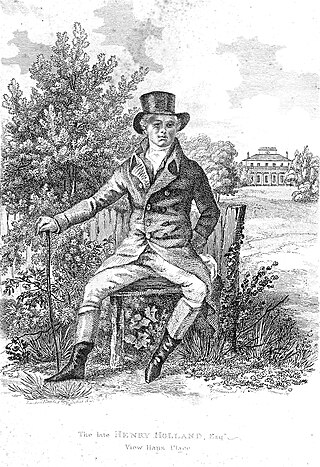
Henry Holland was an architect to the English nobility.

The Portman Estate, covering 110 acres of Marylebone in London’s West End, was founded in 1532 when the land was first leased to Sir William Portman.

Coade stone or Lithodipyra or Lithodipra is stoneware that was often described as an artificial stone in the late 18th and early 19th centuries. It was used for moulding neoclassical statues, architectural decorations and garden ornaments of the highest quality that remain virtually weatherproof today.

34 Montagu Square is the address of a London ground floor and basement flat once leased by Beatles member Ringo Starr during the mid-1960s. Its location is 1.3 miles (2.09 km) from the Abbey Road Studios, where The Beatles recorded. Many well-known people have lived at the address, including a British Member of Parliament, Richard-Hanbury Gurney, and the daughter of the Marquess of Sligo, Lady Emily Charlotte Browne. The square was named after Elizabeth Montagu, who was highly regarded by London society in the late 18th century.
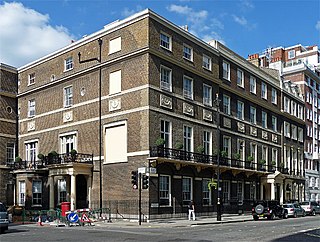
Home House is a Georgian town house at 20 Portman Square, London. James Wyatt was appointed to design it by Elizabeth, Countess of Home in 1776, but by 1777 he had been dismissed and replaced by Robert Adam. Elizabeth left the completed house on her death in 1784 to her nephew William Gale, who in turn left it to one of his aunts, Mrs Walsh, in 1785. Its later occupants included the Marquis de la Luzerne during his time as French ambassador to the Court of St. James's, the 4th Duke of Atholl, the 4th Duke of Newcastle, Sir Francis Henry Goldsmid, and Lord and Lady Islington.
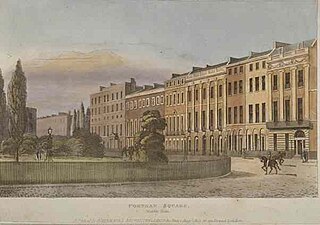
Portman Square is a garden square in Marylebone, central London, surrounded by townhouses. It was specifically for private housing let on long leases having a ground rent by the Portman Estate, which owns the private communal gardens. It marks the western end of Wigmore Street, which connects it to Cavendish Square to the east.

Dorchester House was a mansion in Park Lane, Westminster, London, which had many different forms over time. The last version used as a private residence was that built in 1853 by Robert Stayner Holford. It was demolished in 1929 to make way for the present Dorchester Hotel.

The Hyatt Regency London – The Churchill is a five star hotel located on Portman Square, north of Marble Arch in central London, England. It is owned by The Churchill Group Ltd and is currently operated by Hyatt Hotels Corporation.
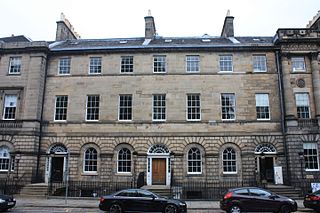
The Georgian House is an 18th-century townhouse situated at No. 7 Charlotte Square in the heart of the historic New Town of the city of Edinburgh, Scotland. It has been restored and furnished by the National Trust for Scotland, and is operated as a popular tourist attraction, with over 40,000 visitors annually.
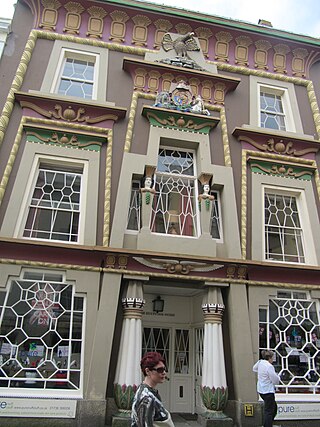
Egyptian Revival architecture in the British Isles is a survey of motifs derived from Ancient Egyptian sources occurring as an architectural style. Egyptian Revival architecture is comparatively rare in the British Isles. Obelisks start appearing in the 17th century, mainly as decorative features on buildings and by the 18th century they started to be used in some numbers as funerary or commemorative monuments. In the later 18th century, mausoleums started to be built based on pyramids, and sphinxes were used as decorative features associated with monuments or mounted on gate piers. The pylon, a doorway feature with spreading jambs which support a lintel, also started to be used and became popular with architects.
Harcourt House was a palatial residence built in about 1722 by Thomas Archer on Cavendish Square. The main structure was largely demolished in 1906 leaving only the southern wing on the corner with Margaret Street, now Flanders House. The southern wing of the building survives today as 1A Cavendish Square.

Chartered Accountants' Hall is a Grade II* listed building located at 1 Moorgate Place in the City of London. It is the headquarters of the Institute of Chartered Accountants in England & Wales (ICAEW). The Hall is one of the richest examples of late Victorian architecture in the City and has been praised for its seamless integration of sculpture.

Leicester House was a large aristocratic townhouse in Westminster, London, to the north of where Leicester Square now is. Built by the Earl of Leicester and completed in 1635, it was later occupied by Elizabeth Stuart, a British princess and former Queen of Bohemia, and in the 1700s by the two successive Hanoverian princes of Wales.



















